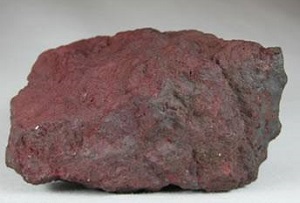Physical Properties and Uses of Hematite
Hematite is one of the most abundant minerals on Earth's surface and in the shallow crust. It is an iron oxide with a chemical composition of Fe2O3. It is a common rock-forming mineral found in sedimentary, metamorphic, and igneous rocks at locations throughout the world.
Hematite is the most important ore of iron. Although it was once mined at thousands of locations around the world, today almost all of the production comes from a few dozen large deposits where significant equipment investments allow companies to efficiently mine and process the ore.

Physical Properties of Hematite
Hematite has an extremely variable appearance. Its luster can range from earthy to submetallic to metallic. Its color ranges include red to brown and black to gray to silver. It occurs in many forms that include micaceous, massive, crystalline, botryoidal, fibrous, oolitic, and others.
Even though hematite has a highly variable appearance, it always produces a reddish streak. Students in introductory geology courses are usually surprised to see a silver-colored mineral produce a reddish streak. They quickly learn that the reddish streak is the most important clue for identifying hematite.
Hematite is not magnetic and should not respond to a common magnet. However, many specimens of hematite contain enough magnetite that they are attracted to a common magnet. This can lead to an incorrect assumption that the specimen is magnetite or the weakly magnetic pyrrhotite. The investigator must check other properties to make a proper identification.
Uses of Hematite
Hematite is the world’s most important ore of iron. Although magnetite contains a higher percentage of iron and is easier to process, hematite is the leading ore because it is more abundant and present in deposits in many parts of the world.
hematite pigments
Hematite Pigment: Hematite was one of the first pigment minerals used by people. At least 40,000 years ago, people obtained hematite, crushed it into a fine powder, and used it to make paints. Shown above are commercial hematite pigments that are available today. From top left, going clockwise, they are: Blue Ridge Hematite, Blue Ridge Violet Hematite, Venetian Red, and Pozzuoli Red. Since the Renaissance, pigments have often been named after the locations where they were produced. The color variations are a result of the type of hematite used and the impurities, such as clay and other iron oxides, that are commingled with it.
hematite gems
Hematite gems: Hematite and taconite are often made into tumbled stones or cut into cabochons and beads. These are popular as inexpensive jewelry items. Tumble-polished hematite is also popular as a "healing stone." Some people believe that carrying it will help relieve certain medical problems. This use has no scientific merit and can actually be harmful because it diverts people who need medical attention from seeing a doctor.
Hematite is used for a number of other purposes. It is a very dense and inexpensive material that is effective at stopping x-rays. For that reason it is used for radiation shielding around medical and scientific equipment. The low cost and high density of hematite and other iron ores also makes them useful as ballast for ships.
Hematite can also be ground to a fine powder that when mixed with water will make a liquid with a very high specific gravity. These liquids are used in the "float-sink" processing of coal and other mineral material. The crushed coal, which has a very low specific gravity, is placed on the heavy liquid and the light clean coal floats, while high-specific-gravity impurities such as pyrite sink.
Finally, hematite is the material used to make polishing compounds known as "red rouge" and "jeweler's rouge." Red rouge is a hematite powder used to polish brass and other soft metals. It can be added to crushed corn cob media or crushed walnut shell media for tumble-polishing brass shell casings. Jeweler's rouge is a paste used on a soft cloth to polish gold and silver jewelry.
);You may like
See also
Lastest Price from Hematite manufacturers

US $600.00/T2024-04-24
- CAS:
- Min. Order:
- 0.1T
- Purity:
- 98%
- Supply Ability:
- 20T


